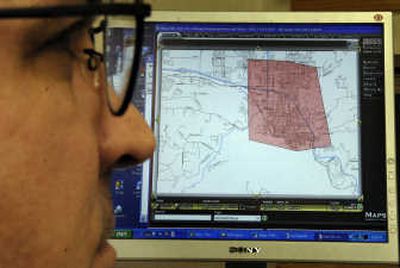North Idaho installs ‘reverse 911’ system

When the next disaster hits North Idaho – whether flood, blizzard or a flu pandemic – residents likely will get a telephone call at home or the office detailing the calamity and evacuation routes or other instructions.
The Panhandle Health District recently installed an electronic notification system in the Kootenai County 911 Center in Coeur d’Alene. The $32,000 software, bought with grants from the federal Centers for Disease Control, allows emergency services and the health district serving five North Idaho counties to send mass messages to phone numbers in the 911 database.
Kootenai County has agreed to pay about $30,000 for the program’s first three years of operation, but county officials hope that Boundary, Bonner, Benewah and Shoshone counties offer to help cover those costs.The Coeur d’Alene Tribe also contributed $5,000 to the project and will use the system.
Spokane County expects to have a similar system by next summer. Eventually North Idaho and Spokane County intend to work together because officials said disasters, especially fire and ice storms, don’t recognize the state line.
The so-called reverse 911 system is “not perfect, but it’s a whole lot better than trying to knock on doors,” Kootenai County 911 Director Brad Coughenour said.
In its first test, about 10,000 Coeur d’Alene residents received calls warning them a 4:30 a.m. fireworks show would take place during the live “Good Morning America” broadcast on Nov. 28.
The automated calls, which mispronounced “Kootenai” and “Coeur d’Alene,” cautioned people about the pre-dawn blasts that normally would have overwhelmed the 911 Center with calls from spooked residents.
Coughenour said it was a good test-run to ensure the system worked, discover kinks and inform the public of the new communication tool.
And it worked. The 911 Center received few calls when the blasts lit up the downtown sky, and Coeur d’Alene residents were talking about the calls.
Within a few weeks, the health district will notify residents how to put their cell numbers, faxes and e-mail addresses on the call list.
For people with caller ID, the calls will show up as “public safety.”
If people hang up on the automated system, it will call back. Emergency workers will monitor the system; if nobody answers or an answering machine or voice mail picks up, after three attempted calls the workers will make direct contact with that address.
Although the system is similar to those used by telemarketers and political candidates, it is only for public emergency needs.
“We want to make sure when people get that call it’s important to listen to and not some ad for a candidate or nuisance call,” said health district spokeswoman Cynthia Taggart.
Previously when disaster struck, North Idaho residents were notified by the Emergency Alert System, the loud beeping that interrupts radio and television broadcasts, or by media advisories.
“That doesn’t do any good if your TV or radio isn’t on,” said Sandy VonBehren, Kootenai County Office of Emergency Management director. “But if you are at home and the phone rings, that’s one more way to get word out.”
Also, if emergency workers needed to evacuate a specific area in the past – for example during the Coeur d’Alene River’s periodic floods near Cataldo – sheriff’s deputies had to go door-to-door. The phone system is expected to free up manpower and let emergency crews do their work instead of spending hours trying to notify residents.
Using computerized maps, the system can send calls to all numbers in the five northern counties or target specific areas.
Spokane County’s Emergency Services Department obtained $90,000 in federal Homeland Security money last year and is working to install a similar system. But it’s still a few months away, said program coordinator Darrell Ruby.
“We are actually overdue,” Ruby said. “We should have had it by now.”
The county is still researching which type of system it wants and how to pay to maintain it. Eastern Washington University installed a call system shortly after the Virginia Tech shooting in April in which a student killed 32 people on the university’s Blacksburg, Va., campus. The system is widely used on college campuses to send emergency text messages to student, faculty and parent cell phones and e-mail addresses.
Educational Service District 101 also has a similar dialing capacity to notify parents and teachers about school events, such as closures.